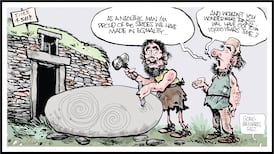This should be a time of unbridled optimism for tourism. By year end, some 9 million tourists will have visited Ireland during the course of 2016. That will be a staggering 50 per cent increase on the levels recorded just six seasons ago.
All of our key source markets are performing well with many turning in double-digit rates of growth. Our visitors appear happy and over the past five years our value for money rating has been climbing to new highs.
Tourism employment is also increasing, in large part due to the Government’s decision to maintain the applicable VAT rate to 9 per cent. At a local level, many of our most remote communities have recorded their best tourist season in several years. Initiatives like the Wild Atlantic Way have no doubt bolstered their fortunes considerably.
Tourism is booming again and the future is bright . . . or is it?
The headline statistics are indeed eye-catching and can easily suggest a growth trajectory without challenge.
However, while tourism earnings have been consistently increasing well ahead of forecast for some time, growth has been greatly fuelled by a benign trading environment characterised by favourable exchange rates, increased air access and adequate industry capacity to accommodate growth.
If 2016 has proven anything, it is that we are living in unpredictable times. For tourism, guaranteed growth is becoming less certain. Whether or not Irish tourism can aspire to greater heights or even consolidate its current position will be very much down to how it responds to emerging issues in the marketplace.
Brexit is the elephant in the room. Irish tourism’s high dependency on a single market – Britain – has been well documented in the past. Prior to the economic downturn, one in every two visitors to Ireland travelled from Great Britain. In the intervening years, our reliance has declined to two in five visitors but it remains uncomfortably high.
Expensive
Within Britain, Ireland is very much perceived as an extension of sorts of its domestic holiday market, competing with Scotland, the Lake District and Cornwall. The weakening of the pound against the euro dictates that the Republic is now also a much more expensive extension of that market in the minds of potential British visitors.
We are seeing as much from our own Fáilte Ireland research which indicates a decline in value-for-money perceptions among British visitors since the UK voted to leave to the EU. The implications are obvious for any business over-reliant on the British market.
However, the sector has other options. While Britain may pull out of Europe, Europe will not pull out of Ireland. Indeed, continental European markets appear to offer the prospect of a more sustainable growth model for the tourism sector over the medium-term.
With the introduction of euro coinage in 2002, less than a quarter of Ireland’s visitors came from mainland Europe. By contrast, last year, that share had risen to 36 per cent, equivalent to some 2.9 million visitors. This represents a more than doubling of tourist traffic across the period.
These are also relatively high-yielding markets and significantly outperform the British market in overall revenue terms despite Ireland’s high reliance on the latter for volume.
No surprise
This shouldn’t come at a surprise to anyone close to the sector. Unlike the British and US markets which evolved initially from familial ties, continental European markets have been developed solidly on the authentic visitor experiences which a holiday in rural Ireland offered those travelling often from industrial and congested zones on the Continent.
It is no wonder that brands like the Wild Atlantic Way and Ireland's Ancient East are resonating so well in places like Germany and France – enormous travel markets with tremendous potential for Ireland, yet where we still command only a modest share.
To safeguard growth, a very deliberate and targeted strategy to rebalance the order books in favour of the relatively more lucrative Continental European markets must be a major plank in the sector's response to emerging difficulties.
This doesn’t simply mean throwing more marketing money at the problem. Sustained growth will demand a much more strategic response: understanding those segments of the market offering greatest return on investment; offering experiences capable of exceeding the expectations of targeted visitors; strengthening the distribution of the “Ireland offering” in the marketplace to reach our key audiences; building stronger partnerships with overseas buyers; and building the capability of Irish trade to service these visitors when they arrive.
Whether 2017 heralds a hard or a soft Brexit, Irish tourism must avoid the complacency so often prevalent in boom times. This is a resilient industry which has weathered in the past the volatility of foot and mouth, 9/11, volcanic ash and a global downturn. By pivoting to Europe and targeting the potential for sustainable growth there, tourism can trade through the new challenges currently emerging.
Shaun Quinn is the chief executive officer of Fáilte Ireland













